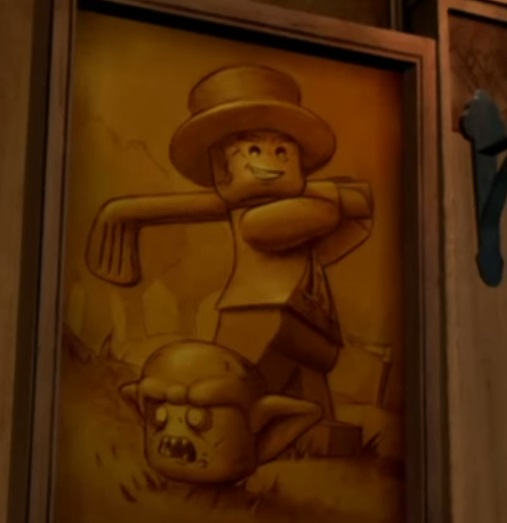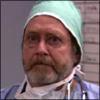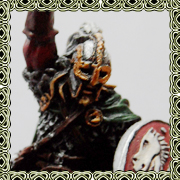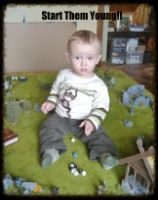The summit was a bit different beast than any other individual piece at Amon Hen, as the lower part of the summit hill will also be used at the Pelennor Fields. Hence, it needed a predominantly yellow grass covering to blend it in with the yellow grass plain terrain tiles, and zero dead leaves. The yellow turf was glued on after the earth-colored latex basecoat had dried (and the rock faces were done, too). I sprinkled in a full covering with fine yellow turf, followed with a salt-and-pepper mix of a bit of burnt grass and green blend fine turfs. In order to make the grass look longer, a liberal amount of coarse yellow turf was added on top. Everything was sprayed with wet water, followed with lots of scenic glue.
For the top part with the Seeing Seat, I first cut a handful of thin wedge-shaped slices of blue foam and glued them in as stone steps leading up to the Seeing Seat. Once the glue was dried, I embossed seams, and added some cracks with a knife. The stepping stones were painted to match the Seeing Seat. A more liberal amount of yellow turf around the steps made them nearly disappear into vegetation.

The fit between the ground and the Seeing Seat structures was tighter than with the Parth Galen stairs, so coarse yellow turf was all that was needed to close the gap. Some underbrush and greener coarse turf was glued here and there, and I also added some fir trees around the summit area. The smaller saplings here and in the lower parts of Amon Hen (e.g. near the “hobbit hidey-hole”) are bits of Woodland Scenics fine leaf foliage.

While the glue was still dry on the fine and coarse turf, I added some Noch golden yellow static field grass near the Seeing Seat to make it look even more like the area did in the movie. The static grass was applied with Noch Gras-master tool. I also glued in a few Army Painter grass tufts for variety.

A final detail was to add tangible moss on top of natural stones, fallen trees, statues and bits of ruin, as well as in the lower parts of stairs and on the bridge. This was done by mixing scenic glue and Scenic Express moss green turf into a “moss paste” (it’s definitely Scenic Express turf, even though I’ve put it into a WS canister shaker). A small spatula was used to apply this paste around the model as appropriate.
A spur-of-the-moment addition: the “horn of Gondor”, i.e. Apple iPod Shuffle and Fuj:tech Soundball speaker inserted into the crypt. I quickly fashioned a door from 3mm Depron painted to match the wall color blocked the view into the structure, keeping the speaker well hidden during the entire model show. I blatantly took the mp3 file from here:
https://soundcloud.com/raul-rodrigues/the-horn-of-gondor and edited it a bit. I extended it to five blows rather than three, and had a short fade-out during the fifth. Not trusting my skills in getting the iPod to play on repeat, I actually made a sound file nearly five hours long, with the five blows sounding out every five minutes (with silence in between). It was fun looking at the surprised eyes of the passers-by as, all of a sudden, the sound of a Gondorian war horn pierced the air in the vicinity of the model.

The assembly test shot earlier had stacks of books to raise the two plain terrain tiles higher than the shore level, but that wouldn’t do in the show. I fashioned a support structure from 1x2 inch lumber in the classic L-girder style familiar from model railroad construction:

The L-girder gets its name from two longitudinal pieces of 1x2” lumber attached together to form a structure (or “girder”) with L-shaped cross-section. Two of these are joined by perpendicular “joists”, to which “risers” are attached. The plain terrain tiles then sit atop these risers at a suitable height so that the lower and upper slope pieces connect them as appropriate.

For transport, I detached one of the L-girders. The joists are only attached with one screw to either girder, so removing four screws & one girder left the remainder of the structure fold neatly into a long (but rather weird-looking) piece of woodwork. I also fashioned side panels from 3mm mdf, painted with dark brown to match the edges of the terrain tiles and slopes. I printed out some screen shots from the movie, as well as a title plaque (“Amon Hen” + Lord of the Rings logo). These were first glued onto 3mm foamboard cut to suitable size; the foamboard-backed images were then glued onto the mdf panels. The panels were secured in place by screwing them into the support structure joists.

Here’s the entire load of stuff to be transported – all the terrain pieces (river shore, three plain flat tiles, lower slope with stairs, small extension hill, upper slope, summit hill in three parts, three forests, six separate ruins or large statues, separate fir trees, support structure, side panels, and about 40 figures in a case. Two trips with my Chrysler PT Cruiser…

The rest, as they say, is history. But I also want to share some goodies I found at the model show – firstly, a brilliant guide book, “Realistic Wood Effects” by AK Interactive (
http://www.ak-interactive.com/ecomm/?acc=Catalog&sacc=view&IDCat=574&idp=9519&idc=3) as well as the associated paints and washes to achieve the incredible wood effects. I also got a set of paints for “humidity and wet effects” with two very nice-looking moss green colors by MIG (
http://www.migjimenez.com/en/weathering-sets/209-humidity-and-wet-effects.html ) - if I had had the latter prior the show, I would have used it for moss effects. But I will definitely utilize both the wood and the moss effects with Helm’s Deep.

I also got a couple of ready-made trees that I’ve been waiting for from a local dealer: Faller sessile oak and a willow tree. I’ve been trying to find ready-made holly trees (to no avail); I think the sessile oaks could be a good substitute. I’ve also hunted for a good-looking H0-scale willow tree which I could use as the Old Man Willow in my model railway – this Faller one is definitely going to be it.

Phew, that was a long post indeed – hope it answers all your questions about how the Amon Hen board was made. Thanks for reading!
 Top
Top Top
Top Top
Top Top
Top Top
Top Top
Top Top
Top Top
Top Top
Top Top
Top Top
Top Top
Top Top
Top Top
Top Top
Top Top
Top Top
Top Top
Top Top
Top Top
Top



 You are one extremely talented hobbyist and your terrain pieces never cease to amaze in their scale and accuracy with such amazing attention to detail. After seeing this, I'm actually scared to see what Helm's Deep will be like!
You are one extremely talented hobbyist and your terrain pieces never cease to amaze in their scale and accuracy with such amazing attention to detail. After seeing this, I'm actually scared to see what Helm's Deep will be like! 













































